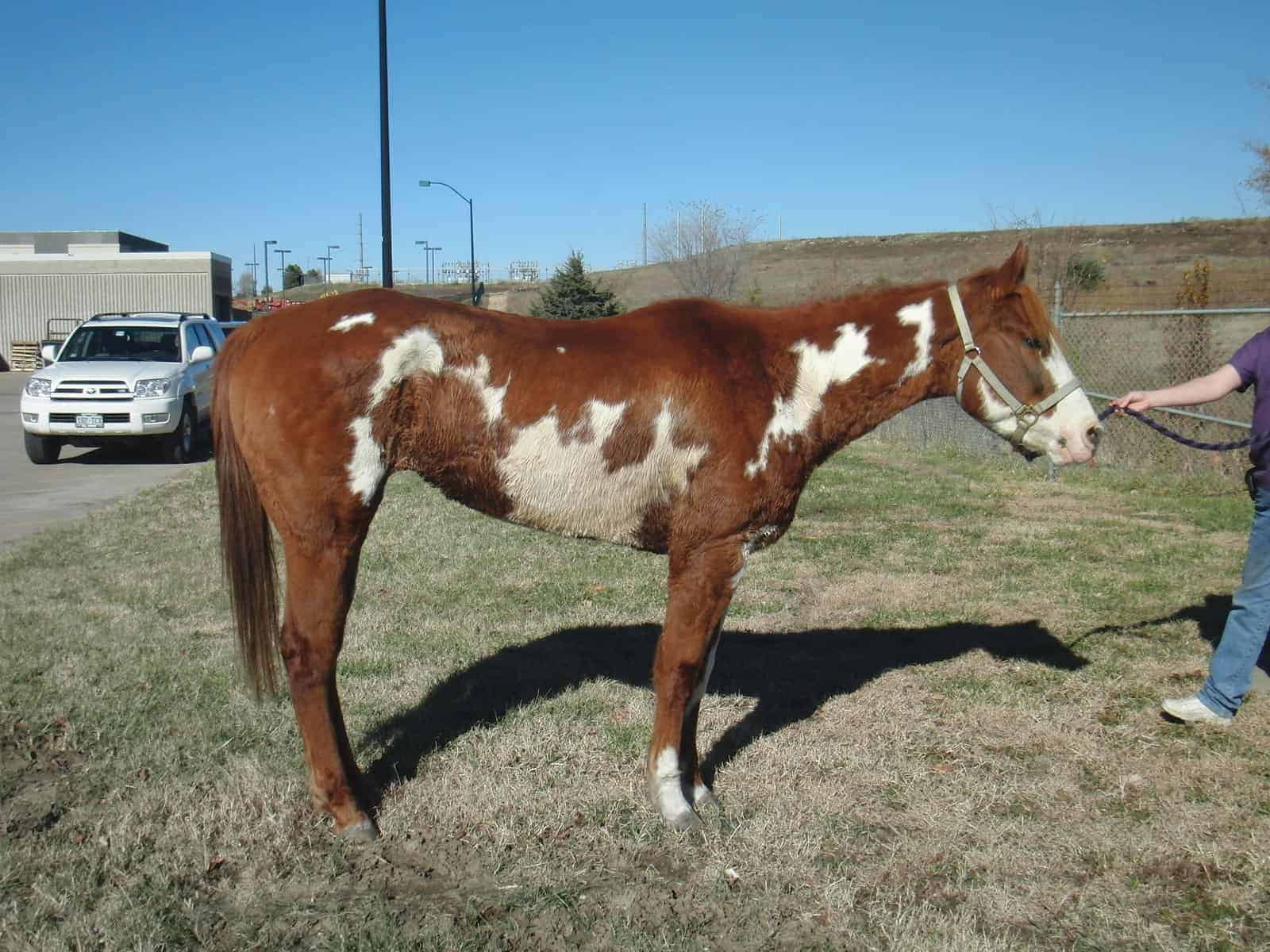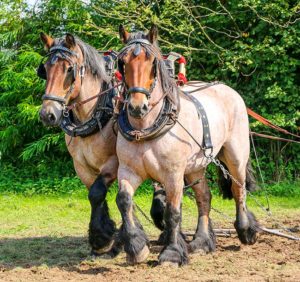Feeding Horses With Neuromuscular Disorders

A correct diet can make these sometimes-debilitating conditions manageable
If your veterinarian has diagnosed your horse with a neuromuscular disorder—that is, one affecting the nerves that control muscle function—your first thought probably isn’t about what he’s eating. You’re likely far more worried about his unsettling muscle atrophy, incoordination, twitching, trembling, and/or sweating. But researchers have discovered that diet might play an important role in either the onset or management of several of these conditions. In this article we’ll discuss best feeding practices for horses affected by any of the following five neuromuscular disorders: equine motor neuron disease (EMND), polysaccharide storage myopathy (PSSM types 1 and 2), neuroaxonal dystrophy (NAD), and equine degenerative myeloencephalopathy (EDM).

Equine Motor Neuron Disease
This condition affects the neurons, or nerve cells, that transmit impulses to slow-twitch muscle fibers. These fibers, which allow the horse to perform lower intensity, higher endurance movements, rely on oxidative processes, meaning they use oxygen to burn fuel (from the diet) for energy. Affected horses might display muscle wasting (the atrophy described earlier) leading to weight loss, muscle twitching, sweating, and prolonged periods of recumbency, or the inability to rise, that can warrant euthanasia in severe cases. Scientists have tied a dietary deficiency and low blood plasma concentrations of vitamin E to this disorder. Vitamin E is a potent antioxidant and fat-soluble vitamin, which means it cannot be absorbed into the small intestine’s epithelial cells and transported into the bloodstream unless there are sufficient fat levels in the horse’s diet. Clinical signs of EMND only become obvious after the horse has been vitamin E-deficient for a prolonged period of time—at least 18 to 21 months. However, not all horses that suffer from a prolonged vitamin E deficiency develop EMND.
“It appears that certain horses may be at greater risk to develop signs of neuromuscular disease when on low vitamin E diets than others,” says Carrie Finno, DVM, PhD, Dipl. ACVIM, who focuses her research at the University of California, Davis, School of Veterinary Medicine on risk factors associated with equine neuromuscular diseases. “At-risk horses may be more susceptible to oxidative stress (what happens when oxygen isn’t used to burn fuel), and clinical signs may only appear when they are maintained on vitamin E-deficient diets such as hay-based diets with limited pasture access and no additional supplementation.”
General Dietary Recommendations
Provide healthy horses that don’t have adequate fresh green forage access with 600-800 IU per 500 kg of body weight per day of d-α tocopherol acetate, adjusted based on blood work. Working horses might require more than this, and owners should base supplemental requirements on serum levels of vitamin E.
Provide healthy mares during their last trimester that don’t have access to adequate fresh green forage with 800-1,000 IU per 500 kg of body weight per day of d-α tocopherol acetate, adjusted based on blood work.
Give horses that have low vitamin E serum concentrations (<2 IU/kg) 5,000 IU/450 kg body weight of water soluble d-α-tocopherol. Base continued supplementation and dose adjustments on repeated serum concentration assessments.
Base PSSM type 1 horses’ diets on a grass hay with a nonstructural carbohydrate (NSC) level of 12% or lower. If you don’t know the hay’s NSC level, soak it for 30 minutes to remove soluble carbohydrates (and discard the soak water). Easy keepers should then be fed a low-calorie ration balancer per the manufacturer’s directions. Contact your preferred feed company for information about their available ration balancer. For horses needing additional calories to maintain weight and tolerate exercise, provide additional calories using fat sources such that about 20% of the ration’s total calories come from fat. Common fat sources include rice bran and fortified feeds with a fat content of 12% or more.
Base PSSM type 2 horses’ diets on a moderate-NSC grass hay, possibly adding alfalfa as an additional protein source if the hay has low protein levels. Feed a high-protein ration balancer per the manufacturer’s directions. If your horse requires even more calories, feed a moderate-NSC, higher-fat performance feed per the feeding directions.
For horses with either form of PSSM, ensure they have normal serum vitamin E levels and supplement as necessary. Owners should seek a qualified equine nutritionist’s advice when developing these animals’ diets.
—Clair Thunes, PhD
Good-quality fresh pasture is an abundant source of natural vitamin E, often capable of supplying 100 IU (international units) per kilogram of dry matter (DM) a day. Hay provides significantly less, and vitamin E levels in hay can drop by as much as 50% within one month of harvest because of this nutritent’s instability. Therefore, if your horse does not have adequate access to green forage, EMND researchers recommend you supplement with 1 IU/kg body weight per day of vitamin E.
Finno cautions that not all vitamin E supplements are created equal. “Vitamin E is a term used to describe a family of compounds known as tocopherols and tocotrienols,” she says. “α-tocopherol (the only biologically active form of vitamin E) exists in both natural (d) and synthetic (dl) formulations. Differences exist in how the liver (which is responsible for maintaining α-tocopherol levels in the blood) takes up forms, with a higher preference given to d-α tocopherol than the dl-α tocopherol form.”
D-α tocopherol does not require fat for absorption, and scientists have proven that it is more bioavailable, more readily absorbed, and has greater antioxidant activity than the synthetic version. Finno says she typically recommends this form to owners supplementing horses diagnosed with EMND, NAD, EDM, and/or vitamin E deficiencies.
Neuroaxonal Dystrophy and Equine Degenerative Myeloencephalopathy
These two conditions result from abnormalities of certain neurons within the nervous system. They are very similar—which is why we’ve paired them—and scientists believe NAD is the underlying basis for EDM. Clinical signs for both include ataxia (incoordination), abnormal circling, and a lack of proprioception (knowing where one’s feet are). Mild cases simply exhibit performance issues, whereas severe cases might require euthanasia.
Veterinarians have reported NAD/EDM cases in a wide range of breeds, including Quarter Horses, Paints, Paso Finos, Standardbreds, Throughbreds, Morgans, Arabians, Lusitanos, Appaloosas, Tennessee Walking Horses, Fjords, Haflingers, and a Welsh pony. The condition does appear to have a strong genetic component, as scientists have noted clusters of cases in closely related horses. In fact, foals born from mares that have previously had a foal diagnosed with EMD are 25 times more likely to develop the condition than those from dams of only healthy foals, says Finno. Most horses start displaying clinical signs from 6 to 12 months of age, but onset can occur anytime from birth to 36 months.
While not present in all cases, a vitamin E deficiency occurring when particular areas of the nervous system are developing can trigger NAD/EDM expression in many. “(The affected horse) has to have the underlying genetic predisposition and a vitamin E deficiency during a specific time in postnatal development,” says Finno.
Newborn foals typically receive vitamin E via their dam’s colostrum (first milk), which is why it’s vital that pregnant mares receive adequate supplemental vitamin E during their last trimester. Owners of foals born to mares that have had an affected foal previously should supplement the youngster around weaning. Any foal owner, might consider testing their foal’s serum vitamin E levels, however, and then supplement accordingly. Once a foal starts displaying signs of NAD/EDM, no amount of vitamin E will reverse the disease.
“You need to know whether your horse needs supplementing, and you need to know whether your supplementation plan is working; without blood work you have no idea,” Finno says. And even when treatment begins before clinical signs appear, “We have found the response to vitamin E supplementation to be very individual.”
Polysaccharide Storage Myopathy Type 1
PSSM type 1 is a condition commonly seen in draft breeds. Stephanie Valberg, DVM, PhD, Dipl. ACVIM, ACVSMR, a professor and the director of the University of Minnesota Equine Center, in St. Paul, has reported in studies that it affects 36% of Belgians, more than 50% of Percherons, and about 10% of Paints and Quarter Horses. Like the other conditions mentioned, PSSM is manageable unless severe, in which case it can become life-threatening.
Dr. Stephanie Valberg
In 2008 Valberg and her team at the University of Minnesota discovered that a genetic mutation in the GYS1 (glycogen synthase 1) gene causes the disease. Horses with this mutation accumulate large amounts of glycogen (stored glucose) in their muscle tissues, which leads to clinical signs of muscle soreness and tying-up shortly after exercise. Therefore, managing this condition involves reducing the affected horse’s dietary nonstructural carbohydrate (NSC) intake to 12% or less to maintain low blood insulin levels (these rise when the body tries to transport glucose to body cells) and reduce muscle glycogen stores. Diet alone, however, will not resolve a horse’s PSSM 1, says Valberg; he must also exercise daily (with the activity introduced gradually), which helps maximize muscle’s ability to burn glycogen. If, with increasing exercise, horses require additional calories, owners should choose a low-NSC and/or high-fat (which helps prevent horses from storing too much glucose) feed source.
Not all PSSM type 1 horses should consume fat: “Often horses with this condition are easy keepers, and excessive fat can cause unnecessary weight gain,” Valberg says. “The calories needed for an appropriate weight should be considered first, and horses fed a low-NSC grass hay and a good-quality ration balancer that provides the minerals and vitamins often missing in hay. When extra calories are needed to maintain body condition and exercise tolerance, then fat should be utilized.”
Can the PSSM-2 Horse Still Perform?
Alyssa Pitts, a Grand Prix dressage rider from Snohomish, Washington, has had several horses in her barn diagnosed with PSSM type 2. She has come to recognize the subtle signs that might point to type 2 PSSM.
“I’m suspicious of PSSM with the obvious ‘lazy’ horse but I also look at the muscling of the horse, as PSSM horses won’t be well-muscled, and they won’t pick up muscle regardless of the training, fitness, or correct riding,” Pitts says.
“They often have muscle atrophy (wasting) in the hindquarters and over their backs, as well as poorly developed muscles in their necks and shoulders,” she continues. “When I ride them they feel tight in their body … I like to say they don’t move through their body, and they seem to have a particularly hard time with the canter. I’ve also seen intermittent lameness, especially in the hind end.”
This is a description with which Stephanie Valberg, DVM, PhD, Dipl. ACVIM, ACVSMR, a professor and the director of the University of Minnesota Equine Center, in St. Paul, is familiar. “I hear over and over that these horses can’t step under or collect as well as they should, and that they have a hard time getting into and sustaining a collected canter,” she says. “It comes down to the fact that they just don’t have the strength in the proper muscles.”
The good news is that with the diet and exercise regimen described in this article, these horses do improve. In Pitt’s case all of the horses she has worked with have gone on to perform quite well, even at Grand Prix level. Not all horses with PSSM type 2 will be able to live up to their potential, however.
—Clair Thunes, PhD
Polysaccharide Storage Myopathy Type 2
Horses with PSSM type 2 display the same clinical signs as horses with type 1, but they do not have the GYS1 genetic mutation. “Currently we do not know the exact cause of type 2 PSSM,” explains Valberg. Though affected animals lack the mutation, “biopsy samples … show small regions of glycogen aggregation within cells. Our current research suggests that the total amount of glycogen being stored is not abnormally high with type 2 PSSM.”
Another difference between the two PSSM conditions is that type 2 appears to be more common in high-performance breeds. Of the biopsy samples Valberg’s lab processes, about 80% of Warmbloods with PSSM have type 2. “We also see cases in light breeds such as Morgans, Arabians, Thoroughbreds, and some Quarter Horses,” she says.
The good news is that—like PSSM type 1 horses—these horses do improve with the correct diet and exercise regimen. Owners just have to recognize that small changes in management can have a big impact on these horses, says Valberg, so sticking to the treatment plan is crucial. Horse owner Louise Hamm, for instance, has a Warmblood gelding with type 2 PSSM, and she had to fine-tune his diet for more than a year before he could return to work. Even slight diet changes, such as going from orchard to timothy hay, cause him huge setbacks.
“Our work is leading us to believe that there is a tight relationship between appropriate exercise, diet, and timing of the diet,” Valberg says. “These horses require a gradual approach to training over at least a two-month period … while at the same time they need to be fed a diet that supports the turnover and generation of muscle.”
Providing these horses with a quality protein source might be important as well. This is because the low-NSC hays that PSSM horses typically consume tend to be more mature and, therefore, low in protein, says Valberg.
Owners should not rely on oil as a calorie source, as it adds nothing to the ration other than calories. “A better approach than pouring corn oil over alfalfa pellets for these horses is the use of high-protein ration balancers or, if extra calories are needed, feeding a performance feed with moderate NSC and higher fat per the manufacturer’s instructions,” says Valberg. “Our recommendations will likely be refined further as we gather more data and a better understanding of the specifics relating to this condition.”
Take-Home Message
If you suspect your horse has a condition such as PSSM, it might be tempting to simply adopt these management and feeding directions without first attaining a confirmed diagnosis. However, Finno and Valberg caution against this, as the signs horses with neuromuscular disorders display are not necessarily unique to these conditions. For example, some of the signs seen under saddle in PSSM horses are similar to those with gastric ulcers. Without an accurate diagnosis for one or the other, the horse could be treated for the wrong condition.
For the best outcome, horse owners must work with their veterinarian to achieve an accurate diagnosis and seek a qualified equine nutritionist’s expertise if needed. “Nutrition plays an important role in the prevention and or management of these diseases,” says Valberg. “If your vet does not feel comfortable creating a nutritional plan specific to the disease your horse has, ask them to guide you to a qualified nutritionist with a graduate degree in nutrition who can help.”

Written by:
Clair Thunes, PhD
Related Articles
Stay on top of the most recent Horse Health news with















